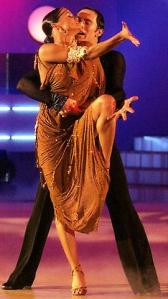 Hi Guys! We’re back. Now we’re going to reveal the story of the rumba. Yep, The Dance of Love.
Hi Guys! We’re back. Now we’re going to reveal the story of the rumba. Yep, The Dance of Love.
Do you know that the word “rumba” comes from the verb “rumbear”? It means going to parties, dancing, and having a good time. Now you know, then. Rumba itself actually is a dance term with two quite different meanings.
First, it means Cuban event of African style, organically related to the rumba genre of Afro-Cuban music. There are several styles of this rumba, the most common being the guaguancό.
Second, it refers to one of the ballroom dances which occurs in social dance and in international competitions.
So, The Rumba that we usually dance is the second one. The Rumba is the slowest of the five competitive International Latin dances: the paso doble, the samba, the cha cha cha and the jive being the others. This ballroom rumba was also danced in Cuba to a rhythm they call the bolero-son; the international style was derived from studies of dance in Cuba in the pre-revolutionary period.
The modern international style of dancing the rumba derives from studies made by dance teacher Monsieur Pierre (Pierre Zurcher-Margolle), who partnered Doris Lavelle. Pierre, from London, then visited Cuba in 1947, 1951 and 1953 to find out how and what Cubans were dancing at the time.
The international ballroom rumba is a slower dance of about 120 beats per minute which corresponds, both in music and in dance to what the Cubans of an older generation called the bolero-son.
All social dances in Cuba involve a hip-sway over the standing leg and, though this is scarcely noticeable in fast salsa, it is more pronounced in the slow ballroom rumba. In general, steps are kept compact and the dance is danced generally without any rise and fall. This style is authentic, as is the use of free arms in various figures. The basic figures derive from dance moves observed in Havana in the pre-recolutionary period, and have developed their own life since then. Competition figures are often complex, and this is where competition dance separates from social dance. Details can be obtained from the syllable of dance teaching organizations and from standard texts.
Rumba is the spirit and soul of Latin American music and dance. The fascinating rhythms and bodily expressions make the Rumba one of the most popular ballroom dances. (VDE)
Sources:


